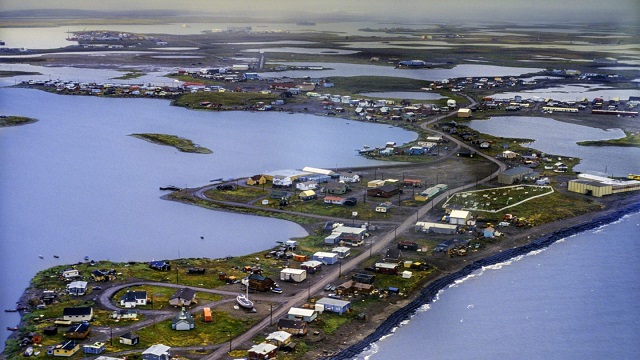Canadian Energy Centre
New compressed natural gas project to bring energy security to Canada’s north

Aerial view of the Hamlet of Tuktoyaktuk on the shores of the Beaufort Sea in the Canadian Arctic. Getty Images photo
From the Canadian Energy Centre
By Cody Ciona
‘The whole project is for the purpose of addressing the energy security issue that many northerners face’
The recent approval of the first compressed natural gas facility in the Northwest Territories is bringing energy security one step closer to remote and Indigenous communities in Canada’s north.
The Inuvialuit Energy Security Project (IESP), owned by the Inuvialuit Regional Corp. , will be located 16 kilometres south of Tuktoyaktuk. The project, recently approved by the Canadian Energy Regulator, will convert natural gas into compressed natural gas (CNG), propane, and diesel for the Inuvialuit Settlement region.
“The whole project is for the purpose of addressing the energy security issue that many northerners face, but particularly northerners that are at the end of a very long road,” said Inuvialuit Petroleum Corporation special advisor Kate Darling.
The natural gas will be supplied by the Tuk M-18 well, which is also owned by the Inuvialuit, and transported to local customers for power, heat, and fuel.
Currently, the region is serviced by the Inuvik Gas Project (natural gas from two wells at the Ikhil reservoir, 50 kilometres northwest of Inuvik), and by truck from the south in B.C. The Ikhil wells’ reserves are now critically low, which led to the push for the IESP. The Tuk M-18, however, is estimated to have more than 100 years’ worth of reserves.
About 200,000 people in Canada have no connection to an energy grid or natural gas distribution systems. This includes nearly 100,000 people in the northern territories.
In the Northwest Territories, refined petroleum products like diesel make up 74 per cent of end-use demand, brought in by trucks. In Inuvialuit’s case, that’s a 5,000-kilometre round trip including a ferry ride. In the past, Inuvialuit has faced potential operation disruption of the ferry service, which put the community in an emergency fuel situation.
“[The IESP] could provide long-term energy to the communities in the region, as well as reducing greenhouse gas emissions, creating long-term employment,” said Duane Ningaqsiq Smith, chair of the Inuvialuit Regional Corporation.
“It represents an Inuvialuit-led solution that takes into account the preservation of our values, advances participation in the northern and national economy, all while reducing emissions and helping preserve our local environment.”
In addition to providing energy security for remote communities, the IESP will have a significant positive impact on emissions reduction. It is estimated it will have a net reduction of around 40,000 tonnes of emissions per year, equivalent to the yearly emissions of 9,520 cars.
The project is also expected to support 25 full-time jobs and a further 35 full-time jobs within the local community.
“All in all … the M-18 will really help not just the surrounding communities of Tuk, but create a lot of jobs for locals, which is very good,” said Ryan Yakeleya, a Tuktoyaktuk councillor.
The IESP has already injected over $20 million into local businesses with over 70 Inuvialuit and Gwich’in peoples employed to date, according to the latest project update.
“IPC is committed to developing the IESP and ensuring that as much of the economic benefit and employment opportunities are offered to Inuvialuit,” said Duane Ningaqsiq Smith, IRC Chair and CEO.
The project is expected to begin producing and delivering gas to consumers by the end of 2025.
Canadian Energy Centre
Cross-Canada economic benefits of the proposed Northern Gateway Pipeline project

From the Canadian Energy Centre
Billions in government revenue and thousands of jobs across provinces
Announced in 2006, the Northern Gateway project would have built twin pipelines between Bruderheim, Alta. and a marine terminal at Kitimat, B.C.
One pipeline would export 525,000 barrels per day of heavy oil from Alberta to tidewater markets. The other would import 193,000 barrels per day of condensate to Alberta to dilute heavy oil for pipeline transportation.
The project would have generated significant economic benefits across Canada.

The following projections are drawn from the report Public Interest Benefits of the Northern Gateway Project (Wright Mansell Research Ltd., July 2012), which was submitted as reply evidence during the regulatory process.
Financial figures have been adjusted to 2025 dollars using the Bank of Canada’s Inflation Calculator, with $1.00 in 2012 equivalent to $1.34 in 2025.
Total Government Revenue by Region
Between 2019 and 2048, a period encompassing both construction and operations, the Northern Gateway project was projected to generate the following total government revenues by region (direct, indirect and induced):

British Columbia
- Provincial government revenue: $11.5 billion
- Federal government revenue: $8.9 billion
- Total: $20.4 billion
Alberta
- Provincial government revenue: $49.4 billion
- Federal government revenue: $41.5 billion
- Total: $90.9 billion
Ontario
- Provincial government revenue: $1.7 billion
- Federal government revenue: $2.7 billion
- Total: $4.4 billion
Quebec
- Provincial government revenue: $746 million
- Federal government revenue: $541 million
- Total: $1.29 billion
Saskatchewan
- Provincial government revenue: $6.9 billion
- Federal government revenue: $4.4 billion
- Total: $11.3 billion
Other
- Provincial government revenue: $1.9 billion
- Federal government revenue: $1.4 billion
- Total: $3.3 billion
Canada
- Provincial government revenue: $72.1 billion
- Federal government revenue: $59.4 billion
- Total: $131.7 billion
Annual Government Revenue by Region
Over the period 2019 and 2048, the Northern Gateway project was projected to generate the following annual government revenues by region (direct, indirect and induced):

British Columbia
- Provincial government revenue: $340 million
- Federal government revenue: $261 million
- Total: $601 million per year
Alberta
- Provincial government revenue: $1.5 billion
- Federal government revenue: $1.2 billion
- Total: $2.7 billion per year
Ontario
- Provincial government revenue: $51 million
- Federal government revenue: $79 million
- Total: $130 million per year
Quebec
- Provincial government revenue: $21 million
- Federal government revenue: $16 million
- Total: $37 million per year
Saskatchewan
- Provincial government revenue: $204 million
- Federal government revenue: $129 million
- Total: $333 million per year
Other
- Provincial government revenue: $58 million
- Federal government revenue: $40 million
- Total: $98 million per year
Canada
- Provincial government revenue: $2.1 billion
- Federal government revenue: $1.7 billion
- Total: $3.8 billion per year
Employment by Region
Over the period 2019 to 2048, the Northern Gateway Pipeline was projected to generate the following direct, indirect and induced full-time equivalent (FTE) jobs by region:

British Columbia
- Annual average: 7,736
- Total over the period: 224,344
Alberta
- Annual average: 11,798
- Total over the period: 342,142
Ontario
- Annual average: 3,061
- Total over the period: 88,769
Quebec
- Annual average: 1,003
- Total over the period: 29,087
Saskatchewan
- Annual average: 2,127
- Total over the period: 61,683
Other
- Annual average: 953
- Total over the period: 27,637
Canada
- Annual average: 26,678
- Total over the period: 773,662
Business
Natural gas pipeline ownership spreads across 36 First Nations in B.C.

Chief David Jimmie is president of Stonlasec8 and Chief of Squiala First Nation in B.C. He also chairs the Western Indigenous Pipeline Group. Photo courtesy Western Indigenous Pipeline Group
From the Canadian Energy Centre
Stonlasec8 agreement is Canada’s first federal Indigenous loan guarantee
The first federally backed Indigenous loan guarantee paves the way for increased prosperity for 36 First Nations communities in British Columbia.
In May, Canada Development Investment Corporation (CDEV) announced a $400 million backstop for the consortium to jointly purchase 12.5 per cent ownership of Enbridge’s Westcoast natural gas pipeline system for $712 million.
In the works for two years, the deal redefines long-standing relationships around a pipeline that has been in operation for generations.
“For 65 years, there’s never been an opportunity or a conversation about participating in an asset that’s come through the territory,” said Chief David Jimmie of the Squiala First Nation near Vancouver, B.C.
“We now have an opportunity to have our Nation’s voices heard directly when we have concerns and our partners are willing to listen.”
Jimmie chairs the Stonlasec8 Indigenous Alliance, which represents the communities buying into the Enbridge system.
The name Stonlasec8 reflects the different regions represented in the agreement, he said.
The Westcoast pipeline stretches more than 2,900 kilometres from northeast B.C. near the Alberta border to the Canada-U.S. border near Bellingham, Wash., running through the middle of the province.

It delivers up to 3.6 billion cubic feet per day of natural gas throughout B.C. and the Lower Mainland, Alberta and the U.S. Pacific Northwest.
“While we see the benefits back to communities, we are still reminded of our responsibility to the land, air and water so it is important to think of reinvestment opportunities in alternative energy sources and how we can offset the carbon footprint,” Jimmie said.
He also chairs the Western Indigenous Pipeline Group (WIPG), a coalition of First Nations communities working in partnership with Pembina Pipeline to secure an ownership stake in the newly expanded Trans Mountain pipeline system.
There is overlap between the communities in the two groups, he said.
CDEV vice-president Sébastien Labelle said provincial models such as the Alberta Indigenous Opportunities Corporation (AIOC) and Ontario’s Indigenous Opportunities Financing Program helped bring the federal government’s version of the loan guarantee to life.
“It’s not a new idea. Alberta started it before us, and Ontario,” Labelle said.
“We hired some of the same advisors AIOC hired because we want to make sure we are aligned with the market. We didn’t want to start something completely new.”
Broadly, Jimmie said the Stonlasec8 agreement will provide sustained funding for investments like housing, infrastructure, environmental stewardship and cultural preservation. But it’s up to the individual communities how to spend the ongoing proceeds.
The long-term cash injections from owning equity stakes of major projects can provide benefits that traditional funding agreements with the federal government do not, he said.
Labelle said the goal is to ensure Indigenous communities benefit from projects on their traditional territories.
“There’s a lot of intangible, indirect things that I think are hugely important from an economic perspective,” he said.
“You are improving the relationship with pipeline companies, you are improving social license to do projects like this.”
Jimmie stressed the impact the collaborative atmosphere of the negotiations had on the success of the Stonlasec8 agreement.
“It takes true collaboration to reach a successful partnership, which doesn’t always happen. And from the Nation representation, the sophistication of the group was one of the best I’ve ever worked with.”
-

 Business22 hours ago
Business22 hours agoCarney’s European pivot could quietly reshape Canada’s sovereignty
-

 Alberta22 hours ago
Alberta22 hours agoAlberta’s grand bargain with Canada includes a new pipeline to Prince Rupert
-

 Crime1 day ago
Crime1 day agoManhunt on for suspect in shooting deaths of Minnesota House speaker, husband
-

 Bruce Dowbiggin7 hours ago
Bruce Dowbiggin7 hours agoWOKE NBA Stars Seems Natural For CDN Advertisers. Why Won’t They Bite?
-

 Crime7 hours ago
Crime7 hours agoMinnesota shooter arrested after 48-hour manhunt
-

 Energy7 hours ago
Energy7 hours agoCould the G7 Summit in Alberta be a historic moment for Canadian energy?
-

 Aristotle Foundation4 hours ago
Aristotle Foundation4 hours agoThe Canadian Medical Association’s inexplicable stance on pediatric gender medicine
-

 conflict8 hours ago
conflict8 hours ago“Evacuate”: Netanyahu Warns Tehran as Israel Expands Strikes on Iran’s Military Command



